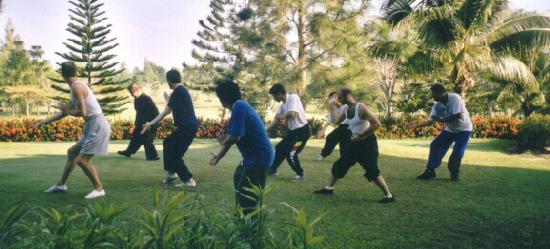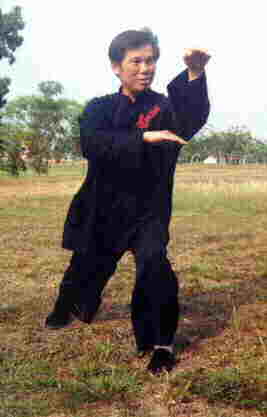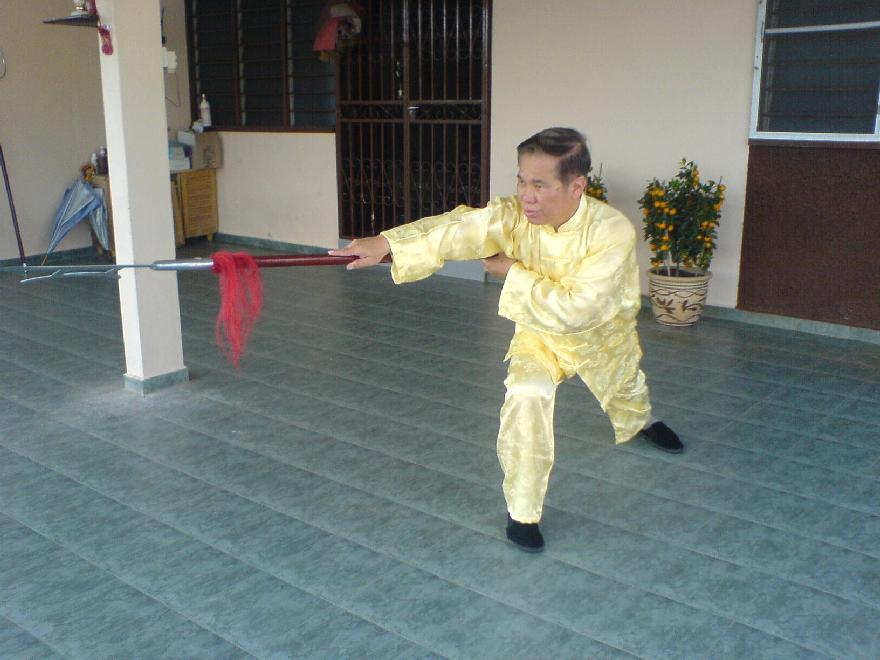March 2002 (Part 2)
SELECTION OF QUESTIONS AND ANSWERS

In Shaolin Wahnam Institute, chi kung is an integral part of kungfu training. Here Sifu Wong leads a group of his senior students in performing a kungfu set. Immediately after the set they go into chi flow, known poetically in the past as “Flowing Breeze and Swaying Trees” or “Yew Foong Pai Lou” in Chinese (Cantonese pronunciation).
Question 1
I'm interested in enhancing my chi kung and kungfu skills to a level I believe I could only achieve by constant training at the Shaolin temples in China or as a direct understudy of a sifu. My ambition is to travel to the temples in China and learn there as many internal arts as I would be allowed. However I'm stuck trying to find information about these temples and how to apply. I hope you can steer me in the right direction,
— Clifford, Australia
Answer
I have received a lot of enquiries similar to yours. The following background information will help many people, especially in the West, to clear a lot of mis-understanding as well as to avoid disappointments.
There were three Shaolin Temples in China in the past. There was a northern Shaolin Temple at Song Shan (Song Mountain) in Henan Province, and two southern Shaolin Temples in Fujian Province, one at Quan Zhou and another at Jiu Lian Shan (Nine-Lotus Mountain).
The northern Shaolin Temple in Henan was the original Shaolin temple, built by imperial decree in the 2nd century during the Six-Dynasty Period. The southern Shaolin Temple at Quan Zhou was built by imperial decree about 1500 years later in the Ming Dynasty about 16th or 17th century. The other southern Shaolin Temple at Jiu Lian Shan was build by the Venerably Zhi Zhan (Extreme Kindness), regarded as the First Patriarch of Southern Shaolin Kungfu, in the 19th century during the Qing Dynasty.
The present Chinese government has restored the northern Shaolin Temple in Henan. For a time at the beginning, the famous Shaolin master the Venerable Hai Deng (Light in the Sea of Suffering) taught traditional Shaolin Kungfu at the northern Shaolin Temple. But, probably due to policy difference as the present Chinese government has always promoted kungfu, called wushu, as a sport and not as a martial art, traditional kungfu at the temple was discontinued.
The northern Shaolin Temple has become very famous both inside and outside China. There is a saying in Chinese that “if one has not been to the Great Wall, he cannot call himself a man”. Now many people in China have changed that saying to “if one has not been to the Shaolin Temple, he cannot call himself a man”. Thousands of tourists, mainly native Chinese, visit the Shaolin Temple everyday. There is no space at the temple for spiritual cultivation or for wushu training.
Some people, especially in the West, say that they have been to China to learn Shaolin Kungfu at the Shaolin Temple. Actually not only what they have learnt is not Shaolin Kungfu but modernized wushu, but also their wushu training was not at the Shaolin Temple but at one of the numerous wushu schools near the temple. The wushu taught in these schools is of a high standard.
Modernized wushu is different from traditional kungfu. Traditional kungfu is a martial art, and great traditional kungfu like Shaolin includes chi kung and spiritual cultivation. Modernized wushu is a sport. A modern wushu student does not learn self-defence, chi kung or spiritual cultivation. I use the prefix “modernized” to avoid possible confusion, because the term “wushu” is actually the term the Chinese use to refer to what in the West would call “kungfu”.
I would like to add that while being a Shaolin disciple and therefore would like traditional Shaolin Kungfu to be taught at the Shaolin Temple, I agree with the Chinese government that given the present situations, promoting wushu and not traditional kungfu among the Chinese population is a right choice. Traditional Shaolin training is for the elite, but the first responsibility of a government is for the mass, not just a selected few. Hence promoting wushu as sport for recreation and low level chi kung where mass instruction is possible, is preferable to traditional kungfu and high level chi kung where personal supervision is required.
Traditional Shaolin Kungfu and high level chi kung are very rare in China today. Some of the best kungfu and chi kung masters in the world are still found in China, but they are the rare exception. What is widely taught in public is modernized wushu and low level chi kung which often degrades into gentle exercise.
If you are interested in modernized wushu and such skills like having a granite slap broken on your chest or bending some spears against your throat, you can readily learn them in China today. Interestingly, past masters did not consider such skills high level chi kung; they called them “da li xi” or “strong man show”, frequently performed at roadsides by travelling hawkers who sold medical pills and medical plasters.
Modernized wushu and such skills are taught in wushu schools, not in temples. You can find many such schools around the Shaolin Temple in Henan, where you may register on the spot. You can graduate in a few months, often with a certificate. You can also stay as long and learn as much as you like. Of course you have to pay the required fees.
But that may or may not be fulfilling your interest in enhancing your chi kung and kungfu skills, or your ambition of learning as many internal arts as you would be allowed to. Much depends on your interpretation of “chi kung”, “kungfu” and “internal arts”. Having a slap of granite broken on your chest, for example, is external. You need not have to practise chi kung to accomplish the feat.
Moreover, it is not necessarily wise to learn as much chi kung, kungfu and internal arts as you can. You would only end up as a learner, and may not even be healthy and fit, or know how to defend yourself. It would be wiser to learn from the best available master you can find, in or outside a temple, and practise, practise, practise — not learn, learn, learn — what he has taught you.
Question 2
For the last 10 years I have developed varicose veins. Do you know of any exercises I can do which will remove the blockage which causes them? My youngest son is autistic. Is this a subject that you are familiar with, and can you suggest any way that we can improve his condition?
— Richard, Ireland
Answer
Practising any genuine chi kung exercise can overcome the problem of varicose veins. This may sound odd, but it is true. The exercise is just a mean to generate energy flow. It is the energy flow that overcome any illness.
I do not know what being autistic is, but I believe practising genuine chi kung can overcome the problem. The reason is simple. From the chi kung perspective, there is only one illness although there may be countless symptoms, and that illness is called yin-yang disharmony, which is due to disruption of harmonious energy flow. The forte of chi kung is to restore harmonious energy flow which, in turn, will result in yin-yang harmony.
That is why I may teach the same set of chi kung exercises to a class of many people with different types of illness, yet they recover from their illness even without me trying to find out what caused their illness. This may be incredible but it is true. One can readily verify my statement by speaking to students who have been in my chi kung classes. What is important is that you must practise genuine chi kung, and not some gentle exercise that pretends to be chi kung.
Question 3
Should chi kung training be more emphasized? Our classes are two hours long and I go three times a week. The 2 hours are broken down as follows: 15 mins stretching, 15 mins drills and stance training, 30 mins forms, 30 mins set fighting, 15 mins exercising (punching, push ups, etc), 15 mins conditioning (sandbag, banging arms) as well as sparring.
Usually chi kung and meditation are done only once a week for 15 mins in which exercises like “Lifting the Sky” are performed. However, from what I have read form your website, chi kung is very important in kungfu training. I just want to know what your opinion is. Should I ask my Sifu if chi kung training should be practised more?
— Alexander, Canada
Answer
Different masters have different methods to teach their students. The training time-table of your school is very good, and has produced excellent results you yourself have experienced.
Yes, if you wish to know more about chi kung training, you should ask your sifu. Make sure that you ask him politely, and never argue with him.
My methods, however, are different. In my school, every movement in Shaolin Kungfu or Taijiquan involves energy and mind. Hence we do not train chi kung or meditation for 15 minutes or an hour per training session, but throughout the training session.
Here, “chi kung” and “meditation” are used not in their restricted meaning, referring to particular chi kung or meditation exercise like “Lifting the Sky” or sitting in a lotus position. They are used in its general meaning, referring to training of energy and mind. For example, in executing a punch in Shaolin Kungfu, we learn to focus our mind on the punch and sink our energy into our dan tian. After completing some combat sequences in Taijiquan, we go into chi flow and then “enter silence”.
Question 4
Would you recommend The Golden Bridge for developing strength? If not, what would you recommend? Also, have you any suggestions for correcting postural imbalances?
— Michael, Ireland
Answer
The Golden Bridge is excellent for developing internal force. Besides the Horse-Riding Stance, it is probably the most used method in Shaolin Kungfu for this purpose. In Taijiquan it is the Three-Circle Stance. For correcting postural imbalances an excellent technique is “Lifting the Sky”.

A Shaolin kungfu pattern known as “White Snake Shoots Venom”
Question 5
I always wonder how does Sinew Metamorphosis, such as an exercise like “Finger Flicking” done so slowly and without any effort, develop internal force? Does the action of Finger Flicking actually store energy in our tendons and ligaments? I am just curious to know how it actually works. I am not asking out of disrespect for you.
— Tham, Malaysia
Answer
Sinew Metamorphosis is a very powerful form of chi kung, and should be learnt from a master. Incorrect training can bring serious side-effects.
It is understandable for many people to wonder how Sinew Metamorphosis, such as an exercise like Finger Flicking, can develop so much internal force, because as they only see its external form they associate it with physical exercise. As physical exercise, it cannot develop internal force, but as chi kung or energy exercise, it will.
Let us use an analogy. Suppose someone has no knowledge of electricity. He will wonder how by merely pressing down a switch you can produce enough energy to boil water in an electric kettle. Of course it is not pressing the switch that boils the water, it is the electricity that does the job. Pressing the switch connects the energy flow.
In the same way it is not merely flicking fingers that produces internal force, it is the vital energy of the practitioner that does the work. Flicking fingers activates the energy flow. Flicking fingers does not store energy in our tendons and ligaments. The energy is stored at various dan tians or energy fields. Flicking fingers sets the energy flowing.
In the same way, when a person overcame his illness by practising chi kung, it was not the physical movements of the chi kung exercises that did the healing, it was energy flow. Because they fail to understand this, some people think that teaching chi kung is very easy. This is particularly so when what they practise is not genuine chi kung but gentle exercise. They start teaching others soon after learning from bogus chi kung instructors.
Question 6
Can you elaborate on the Snake Style Kungfu or the Shaolin Snake style?
— Vincent, USA
Answer
Much of Shaolin Kungfu is inspired by the dragon, the snake, the tiger, the leopard and the crane. They are called the Shaolin five-animal styles. .
The styles of the dragon, the tiger and the crane have also developed into kungfu styles on their own, called the Dragon Style, the Tiger Style and the Crane Style. But I do not know of any Snake Style or Leopard Style.
There is a Snake Style in modernized wushu, but I do not know much about its history and philosophy.
Question 7
What type of chi kung exercises are practised to perform feats like dispersing clouds and healing people over great distances?
Answer
In theory, any chi kung exercise if trained to a very advanced level can enable the master to perform these two feats. But in practice, only high level chi kung can produce such results. Generally, chi kung that focuses on forms is low level, whereas that focuses on mind is high level. One example of high level chi kung that can produces these feats is Shaolin Cosmos Chi Kung.
Question 8
Can anyone become a chi kung master?
Answer
Yes. Basically he must fulfill two requirements. One, he must practise chi kung. Two, he must train for a long time, usually many years.
If he practises gentle exercise, he can never become a chi kung master though ignorant people may address him as one. If he never trains hard he will also not become a master though he may read a lot about chi kung or learn a lot of techniques.
Question 9
Is there an age or sex limit to how far you can exceed in Chi Kung?
Answer
No. Chi kung excellence is not limited by age or sex, although certain types of martial art chi kung and spiritual chi kung may not be suitable for children. Generally the longer you train, which means the older you become, the better you are, irrespective of your sex.
Question 10
Do younger people have an advantage over the elderly in practising chi kung, or the other way around?
Answer
When young and elderly people learn chi kung together, the younger usually have an advantage, not because of the age of the elderly but because the elderly are less agile and have poorer memory. If the elderly learned chi kung when they were young, and have been practising all along, they are usually more efficient than young people.
Question 11
What style of chi kung do you teach and how is it different from Wild Goose Chi Kung, Taoist Neigong, Flying Crane Chi Kung, Swimming Dragon Chi Kung, Bone Marrow Cleansing Chi Kung, and Eighteen Lohan Chi Kung?
Answer
I teach Shaolin Cosmos Chi Kung, which is a generic term covering a wide range of chi kung types, including Eighteen Lohan Hands, Sinew Metamorphosis and Bone Marrow Cleansing.
Shaolin Cosmos Chi Kung is different from Wild Goose Chi Kung, Taoist Neigong, Flying Crane Chi Kung and Swimming Dragon Chi Kung in many aspects, including history, philosophy, methodology and scope.
For example, Shaolin Cosmos Chi Kung has a history of more than a thousand years, whereas Wild Goose Chi Kung and Flying Crane Chi Kung were invented recently — with the inventing masters still living today. Shaolin Cosmos Chi Kung is both dynamic and quiescent, and encompasses more than a hundred different exercises, whereas Taoist Neigong is mainly quiescent, and Swimming Dragon Chi Kung refers to only one particular exercise.
But what most people may not realise is that more important than the type of chi kung they practise are (1) who teaches it, and (2) how they practise it. A master and a mediocre instructor teaching exactly the same type of chi kung to the same students produce very different results. Different students practising the same type of chi kung from the same teacher may also have different results.

Sifu Wong performing a crescent-moon spear
Question 12
How many weapons are you proficient with?
Answer
I am proficient with about 20 different types of weapons, including the staff, the sword, the knife (or broadsword), the spear, the snake-shape lance, the crescent-moon spear, the crescent-mood spade, the Green-Dragon Big Knife, the Bar-the-Gate Big Knife, the battle axe, the trident, the soft-whip, the rods, the round hammer, the umbrella, the bench, and the dagger.
Question 13
Can Chi Kung increase resistance to heat and cold?
Answer
Yes. Internal energy flow can keep the practitioner warm during cold weather, and refresh him when the weather is hot.
Question 14
Does sexual activity drain or steal chi from a man?
Answer
Yes. After having sex, the reduction in size of his dan tian, though slight, is often discernable.
Question 15
Can chi kung breathing techniques increase the amount of time you can hold your breath?
Answer
Yes. This is an objective of chi kung training. Your breathing becomes deeper and slower, which means you can comfortably hold your breath in greater amount for longer time. As a result you have more force and stamina.
Question 16
Since you have been a master of chi kung, or since you reached your highest level of skill, when was the last time you where sick?
Answer
Except for a throat infection, I have not been sick for more than 30 years.
